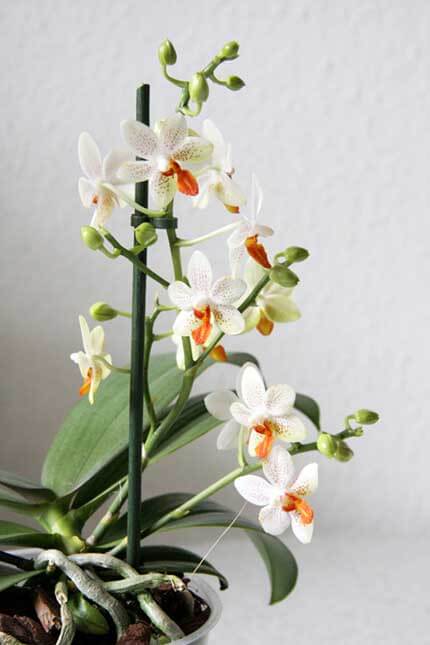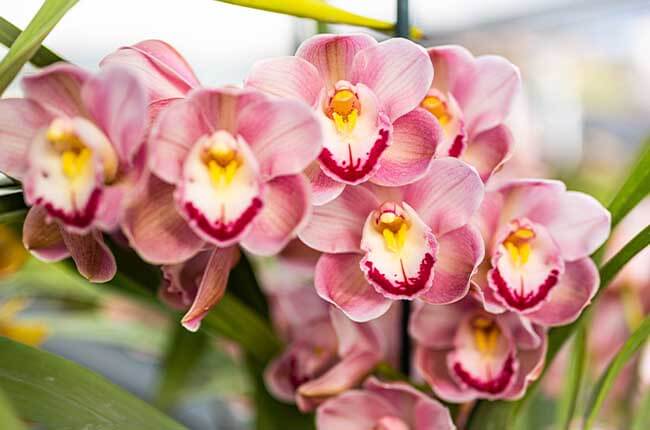Fall has arrived. It’s prime season for most orchids to send out flower spikes.
But what prompts an orchid to burst into bloom? More importantly, how can you encourage your orchid to produce not just one, but multiple flower spikes?
Several factors play a pivotal role in triggering an orchid’s blooming cycle: the presence of growth nodes, experiencing a temperature drop to around 64°F (18°C) for a minimum of two weeks, maintaining a consistent fertilizing routine, ensuring optimal lighting, minimizing stress, understanding the orchid’s genetics, and the strategic removal of old spikes to redirect energy.
In this article, we will delve into each of these seven crucial factors, guiding you on how to coax even the most stubborn orchids into a stunning display, even if they haven’t bloomed in years.
Let’s go!
How can I get more spikes on my orchid?
1. Availability of growth nodes
To produce multiple spikes, the orchid should have grown at least 2 new leaves in the previous vegetative growing season from spring to fall. This is because flower spikes are produced in new locations on the sides of the orchid stem and not in the same location as the previous spike. They sprout from the joints of the stem between leaves, usually two leaves down from the crown.

So, if the orchid has grown only 1 leaf in the new vegetative season, it would only produce 1 flower spike. If it has not grown any leaves at all, the orchid will not send out any flower spikes.
When the previous spike fade and dries out, the blooming season ends and begins the new vegetative season where new leaves would grow.
Therefore, to trigger an orchid to send out flower spikes in the coming fall, the preparation should start in spring by growing new healthy leaves.
2. Drop in temperature
A drop in temperature in fall or early winter (once dropping down to 64 degrees Fahrenheit (or 18 degrees Celcius) for 2-4 weeks is needed to trigger flower spikes. It signals the orchid to end vegetative growth and to start flowering. But the temperature drop is not much to create any stress.
Orchids that are grown indoors with a constant temperature or in tropical climates without much drop in temperature will have difficulties to rebloom. For hot climates, air-conditioning or a fan to lower the temperature to 64 Fahrenheit (18 Celcius) or below will help.
3. Genetics
Genetics is the major deciding factor for the number of spikes an orchid can produce.
Not all Phalaenopsis orchids produce double or multiple flower spikes easily. Some species can only produce one flower spike per season, for example, the Phalaenopsis subgenus of polychilos and their close hybrids.
Also, a young orchid is less prone to having multiple flower spikes than an older orchid.
The NoID orchids and mini orchids that are usually available in the store are complex hybrids that often, though not always, can produce multiple spikes. For example, Phalaenopsis Mini Mark tends to have multiple flower spikes, even when they are under stress. Their spikes are tiny though. This mini orchid is a hybrid between Phalaenopsis Micro Nova and Phalaenopsis Philippinensis.

4. Good fertilizing routine
Proper feeding of nutrients is important for proper flowering.
A proper fertilizing routine for orchids is to “feed weekly weakly”, which means to feed frequently but on a low dose each time. A complete fertilizer with NPK macronutrients of nitrogen, phosphorous and potassium, and micronutrients is needed. Root fertilizing can be combined with foliar feeding.
Without receiving any fertilizer, orchids may not show any immediate symptoms because they grow very slowly, and also they may get some nutrients from the water and decomposing medium.
However, nutrient deficiency will at some point manifest in the yellowing of leaves, slow growth, smaller leaf and bloom size, and a lower quantity of flower spikes and flowers.
Here is a review of these 10 most popular orchid fertilizers in the market.
Orchid Fertilizer | Review |
EDITOR'S PICK 1. Tezula Plants” MSU (13-3-15) | Makes 54.5 gallons, 109 gallons or 218 gallons of liquid fertilizer Pros: Complete nutrition with high Calcium and Magnesium, cheap, perfect for beginners and professional growers with a large collection Cons: none |
2. “rePotme” MSU (13-3.7-15.9) | Makes 64 or 136 gallons of liquid fertilizer Pros: Complete nutrition with high Calcium and Magnesium, cheap (if purchase the big tub) Cons: More expensive than other distributors of the MSU formula |
3. “Better-gro" (20-14-13) | Makes 109 gallons of liquid fertilizer Pros: cheap, a rather complete nutritional profile Cons: lacks Calcium (could be ok with tap water with Calcium, or else require supplement with Cal Mag fertilizer) |
Best Orchid Supplement 4. “General Hydroponics” Cal-Mag (1-0-0) | Makes 192 gallon of liquid fertilizer 5% Calcium and 1.5% Magnesium supplement |
Best Liquid Fertilizer 5. “Jacks” (7-5-6) | Makes 48 gallon of liquid fertilizer
Pros: Urea-free, complete orchid nutrition Cons: low in Calcium and Magnesium |
6. “Grow More” (20-10-20) | Makes 136 gallons of liquid fertilizer
Pros: urea-free, a rather complete nutritional profile (same as Better Gro)
Cons: lacks Calcium, packaging does not prevent humidity which can clump into one big hard rock |
Budget Pick 7. “Miracle-Gro” (granular form) (30-10-10) No products found. | Makes 192 gallon of liquid fertilizer Pros: Very cheap Cons: Not urea-free, no Calcium and Magnesium |
8. “Espoma” (1-3-1) Liquid fertilizer | Makes 24 gallon of liquid fertilizer Cons: low in nitrogen, expensive |
Best Ready-To-Spray Orchid Fertilizer 9. “Miracle-Gro” (0.2-0.2-0.2) Ready-to-spray | Makes 0.125 gallon of liquid fertilizer (for foliar feeding and misting air roots) Pros: ready to use in a spray bottle, great for use on orchids in workplace Cons: not urea-free, no Calcium |
10. “Perfect Plants” (13-11-11) Slow-release | Pros: one application can last for 6 months Cons: no other macro and micro nutrients, can burn roots when near roots |
5. Enough light
It is important to provide enough light for orchids during their vegetative stage from spring to fall to have enough energy to produce multiple spikes.
Good lighting will reflect the overall health of the plant and the quality of the bloom. Without good lighting, the leaves of orchids would be big and dark green, and the flower would be weak and few.
Note: a difference in day length would not trigger blooming.
6. Eliminate stress
The presence of stress drains the energy of an orchid. The source of stress includes a recent loss of roots or leaves, pest, and fungal issues, extreme temperature, lack of moisture, lack of nutrients, etc.
7. Remove old spikes to conserve energy
When flowers drop, you have three options: let the existing spike intact, trim it to a node or remove it completely.
So, should you cut off an old spike?
A spike that has turned brown and is dried has absolutely no chance to rebloom on the same stem. It should be removed completely.
For a green spike with a recent drop of flowers, it should also be removed instead of waiting for it to dry out because they consume the energy of the orchid.
To produce multiple spikes, it is better to divert energy into root development, which makes for a healthier plant and increases the chance of growing new spikes.
The spike should be cut with sterilized cutters at the bottom of the spike, close to the stem.
If the old spikes are kept until they dry out in fall, it is likely that only one spike would be produced in the new blooming season. Even though the old spike may branch out to secondary growth, the new flowers on the secondary growth are not as impressive.
What’s more, orchids with old flower spikes removed would have better blooms in the next blooming season.
How many spikes can an orchid have?
Common hybrids often produce 2 new spikes at a time.
But a few Phalaenopsis species can have 3 or 4 new spikes. Species such as Deliciosa (sp.) have been reported to have 4 new active spikes at one time.
In some cases, old spikes can last for several years while adding new ones each year.
How long does it take for a flower spike to grow?
It depends on the species. For Phalaenopsis, it takes around 3 months from spike to bloom. It could be shorter, depending on the growing conditions, watering, fertilizing, temperature.
A higher temperature increases the metabolic rate of an orchid which may speed up the speed of blooming.
Better growing conditions such as lighting, watering, and enough nutrients promote a strong and healthy orchid, which would have more energy to speed up growing their spikes.
Can an old orchid spike rebloom?
If the orchid is big and strong, some Phalaenopsis orchids can rebloom, even on the same stem on a branched spike, 2 to 3 months after the old flowers have faded. But, the second blooming of flowers would be smaller and less showy.
Why won’t my orchid grow a stem?
Some people have orchids that have not bloomed for one or even a few years. Why?
The reason could be the quality of care. Poor lighting would lead to dark-colored leaves and a very slow growing speed. Since the orchid does not receive enough lighting, it does not produce enough food and energy to bloom.
Stress caused by pest attack, root rot or diseases could put the plant in shock. Instead of focusing on blooming, the energy is diverted into recuperating and growing its vital organs.
The solution would be to put the orchid in a spot receiving good natural lighting. In the Northern Hemisphere, the best would be the morning sun from an Eastern window or filtered light from a Western and Southern window. If the natural lighting is not possible, use a grow lamp.
Also, fertilize it weekly, weakly using 1/4th of the recommended strength to prevent nutrient deficiency. When a spike appears, increase the strength to half the recommended strength weekly.
Conclusion
To produce multiple orchid flower spikes, the basic principle is to care for your orchid properly by providing good lighting and nutrients to support new leaf and root growth. Orchids will have the energy and resources to bloom only when they are growing under conditions free from stress such as diseases, pest attacks, loss of leaves and roots.
A temperature drop to around 62°F (17°C) for at least 2 weeks would trigger an orchid to bloom.
Lastly, know your species because not all orchids can grow multiple spikes.
Happy growing!
Related
- Orchid Nutrition and Fertilizer: A Complete Guide
- Why You Should Foliar Feed Orchids (& How To Do It Right)
- Kelp or Seaweed Extract: Magical Potion for Orchids
Photo credits:
1.Featured image
Photo by Samantha Fortney on Unsplash
2. Phalaenopsis Mini Mark
“Phalaenopsis Mini Mark” by blumenbiene is licensed under CC BY 2.0
- Top 6 Drip Irrigation Systems for Raised Beds (2025) - January 31, 2025
- Top 10 Orchid Fertilizers: A Comprehensive Review (2025) - January 16, 2025
- Top 6 Slow-Release Fertilizers for Houseplants & Veggies (2025) - January 15, 2025










